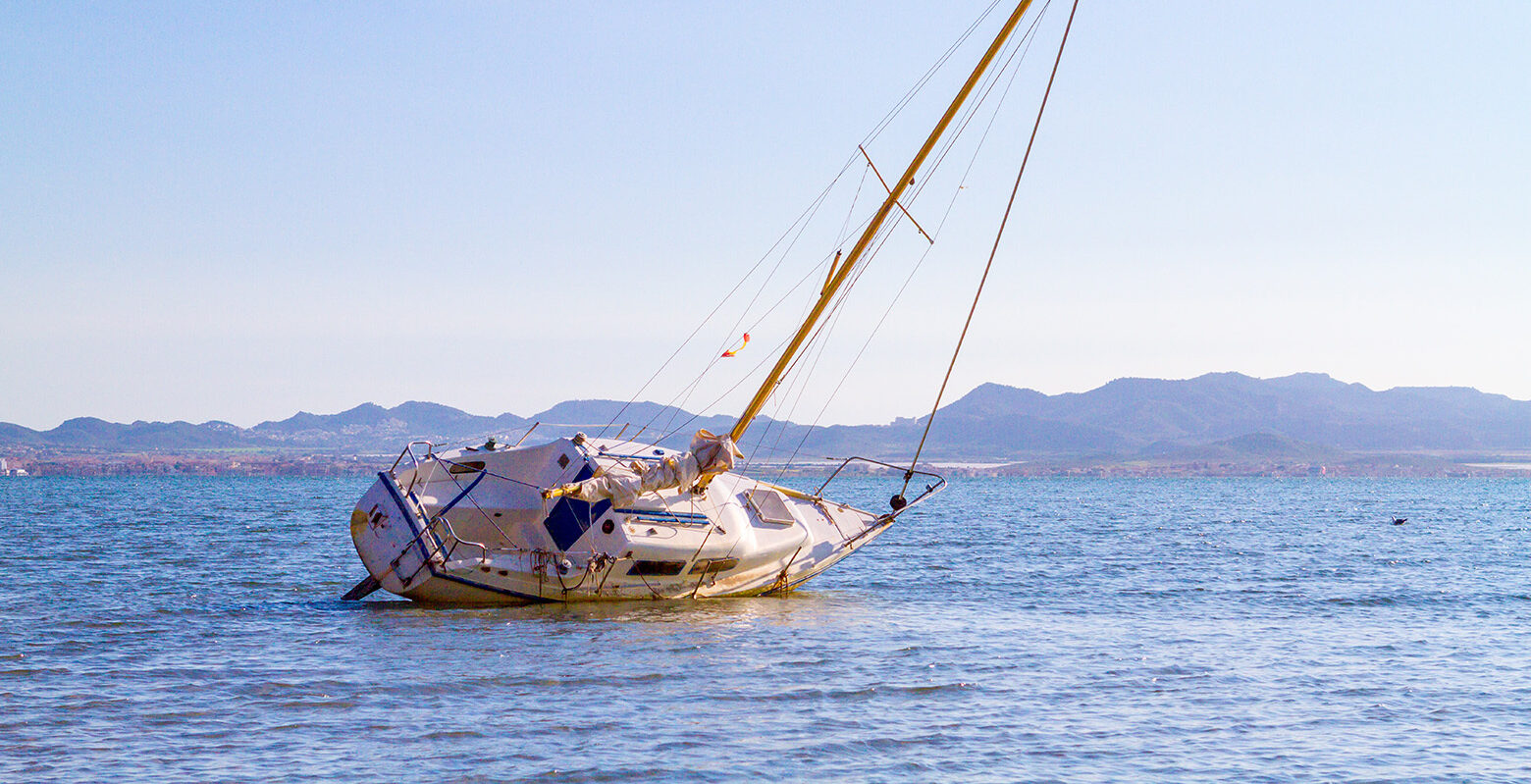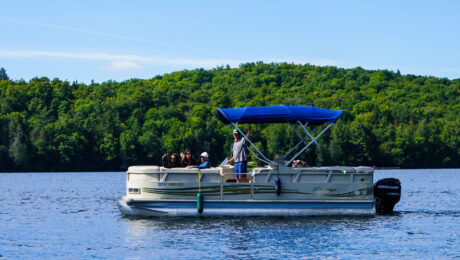Juan and his family spent all morning crabbing and fishing in the brackish waters of Lake Pontchartrain. Now with his wife, two children, and a chest full of Louisiana blue crabs, Juan starts heading through the bayou toward the boat launch.
He is about 10 minutes away when he comes head-to-head with another boat in the channel. He alters course to starboard, only to come to a jarring halt when the bow of his boat runs up on muddy ground. As the other boat passes and the sun of high noon hang over Juan’s head, he asks himself: what now?
Juan’s predicament is one that many boaters have been forced to confront at some point. Running aground situations can be scary and frustrating, but empowering yourself with a plan and knowledge will help you face these situations with a cool and concentrated head.
There are also practices and equipment that can be implemented to avoid running aground. Read ahead for a complete guide to running aground, including preventative measures and how to get out of a grounded situation safely.
What causes a boat to run aground?
Almost any aground situation can be traced back to the weather, tides, and/or equipment malfunction. Routine equipment checks are essential before getting out on the water, in addition to a review of the weather forecast and tide tables. Responsible boaters must also keep in mind the draft of their boat and consult nautical charts to ensure the waterways are deep enough to enjoy safely.
When consulting the nautical chart, be sure to also identify the nature of the seabed, which is helpful to know when trying different tactics to free your boat. A marshy, muddy ground may allow you to free yourself with little to no damage, whereas a rocky ground may require professional help in order to avoid serious structural damage to your craft.
Boaters should also appoint someone to keep a proper lookout so that the helmsman can be alerted to potential dangers and alter course when necessary. For longer voyages, consider rotating the responsibility so that the lookout does not grow tired or worn out, which could result in less vigilance. In the evening and at night, the lookout should be provided with a high-power flashlight to shine onto the water.
Equipment to help you avoid running aground
The most crucial piece of equipment you will need to avoid running aground is a depth sounder or depth finder. Depth finders range from handheld devices that show a simple number of the depth below to large screens with details of the topography and a live feed of living creatures below your hull. Some depth finders even have a feature that allows you to set a shallow alarm, so you can be promptly alerted if you are nearing dangerously shallow water.
Other equipment that can help you in a grounded situation are oars and/or boat hooks, which can be used to push off the land and get your boat back in the water. Winches can be useful too, as you may be able to get free by winching off your kedge anchor line. Winching is a strong and powerful method that generates enough force to get your boat free, but boaters should exercise extreme caution when attempting this method as it requires precision.
What should I do in a running aground situation?
Safety is #1 on the water, so the first thing a responsible boater should do in an aground situation is turn off the engine to prevent any further damage to the vessel. If you went aground while under sail, make sure to douse the sails to prevent the wind from pushing the boat even further aground. Then the boater should promptly check in with all passengers and crew.
Running aground is typically characterized by a sharp jolt, which can send both objects and people flying without warning. After checking in, make sure everyone is fitted with a life vest and then look to the sky for signs of inclement weather. After assessing the weather, begin surveying the boat for any signs of serious structural damage.
This includes checking for a gasoline leak, which can be accomplished by simply sniffing the air around the boat. If the boat appears to be sound and the weather favorable, then the boater must begin work to free the boat themselves.
First, the boater should assess what part of the boat underwater is aground. If it is only partially grounded and if the propeller and rudder are free, it might make most sense to try and reverse the boat under motor.
Another idea would be to set a kedge anchor, which will help prevent waves and current from pushing the vessel farther aground. Keep your anchor line taut and make sure that it’s not tangled in weeds or fauna along the water.
From this point, there are all kinds of different tricks one can use when their boat’s hull is run aground. Many of these tricks require knowledge of the nature of the seabed, so be sure to consult a nautical chart.
For example, when a sailboat runs aground in mud or a shallow sand dune, sailors can throw up the headsail in an attempt to swing the boat around and get the boat loose.
If the wind is favorable, then the keel will loosen the sediment and allow for a safe exit. Alternatively, power-driven vessels may attempt to reverse off or power off at an angle.
All boaters can try rocking the vessel back and forth to get free or using oars or a boat hook to push off the land. If all else fails, the boater must simply wait for deeper water and a higher tide. In some circumstances, they may need to contact a towing company to get free.
Here is a simple checklist to peruse if your boat runs aground:
- Stop the boat’s propulsion - either turn off the engine or douse the sails
- Check-in with passengers and ensure everyone has a life vest
- Look to the sky and check the weather on a mobile device (if available)
- Set kedge anchor
- Survey boat for signs of structural damage (including gas leak)
- Try different methods to get the boat free
- Call a tow service
Please note that the US Coast Guard should only be contacted to evacuate passengers if the grounded boat is at risk of sinking, or if the impending weather seems dark and stormy.
In most cases, the type of distress call should be “Pan-pan” and not “Mayday” (Note that a “Mayday” call is only for life-threatening emergencies, and getting stuck aground on a beautiful day with all of the passengers being accounted for and safe, is not usually considered to be life-threatening).
What do the Navigation Rules of the Road say about running aground?
You may find yourself in a run aground situation near other boaters or in a poor visibility area. Knowing how to communicate to those on the water around you that you have run aground is crucial in avoiding collisions or other accidents which could cause further trouble.
The International and Inland Navigation Rules are designed to keep boaters safe by helping them communicate, so it’s important to know which rules pertain to a grounded boat. Here are the rules you need to be familiar with if your vessel is run aground:
Rule 30—Anchored Vessels and Vessels Aground
(a) A vessel at anchor shall exhibit where it can best be seen:
(i) in the fore part, an all-round white light or one ball;
(ii) at or near the stern and at a lower level than the light prescribed in Rule
30(a)(i), an all-round white light.
(b) A vessel of less than 50 meters in length may exhibit an all-round white
light where it can best be seen instead of the lights prescribed in Rule 30(a).
(d) A vessel aground shall exhibit the lights prescribed in Rule 30(a) or (b) and
in addition, if practicable, where they can best be seen:
(i) two all-round red lights in a vertical line;
(ii) three balls in a vertical line.
(i) A vessel of 12 meters or more but less than 20 meters in length shall not be obliged to give the bell signals prescribed in Rule 35(g) and (h). However, if she
does not, she shall make some other efficient sound signal at intervals of not more than 2 minutes.
(f) A vessel of less than 12 meters in length, when aground, shall not be required to exhibit the lights or shapes prescribed in Rule 30(d)(i) and (ii)
Safety is the most important thing when a boat runs aground. Here are some rules every responsible boater should keep in mind when run aground in an area of restricted visibility:
Rule 35(h) A vessel aground shall give the bell signal and if required the gong signal prescribed in Rule 35(g) and shall, in addition, give three separate and distinct strokes on the bell immediately before and after the rapid ringing of the bell. A vessel aground may in addition sound an appropriate whistle signal.
Rule 35(g) A vessel at anchor shall at intervals of not more than 1-minute ring the bell rapidly for about 5 seconds. In a vessel 100 meters or more in length, the bell shall be sounded in the forepart of the vessel, and immediately after the ringing of the bell, the gong shall be sounded rapidly for about 5 seconds in the after part of the vessel. A vessel at anchor may in addition sound three blasts in succession, namely one short, one long, and one short blast, to give warning of her position and the possibility of collision to an approaching vessel.
Towing memberships
For boaters that want to feel safe and have that little extra coverage in any situation, a towing membership may be an option. If your grounded boat needs towing or any other boat towing situation arises, you can contact a boat towing service.
Many of these services have membership options that will give you some amount of towing for an annual fee. Towing service is covered under the Ahoy! Insurance policy.
Now stay safe and have fun!
There are a myriad of situations that could result in your vessel running aground. The most important thing is to be knowledgeable and to have a plan to get free. Juan got out of his aground situation and got his family home safe because he reacted calmly, paid attention to the weather, and found a way to safely get his vessel free.
Now everyone aboard can take turns being a lookout. And Juan knows: Pay close attention to your anchor, the wind, and the tides. Proceed always at a safe speed, stay within marked channels, and utilize your depth finder so that your enjoyable time on the water doesn’t turn into a grounded situation.


